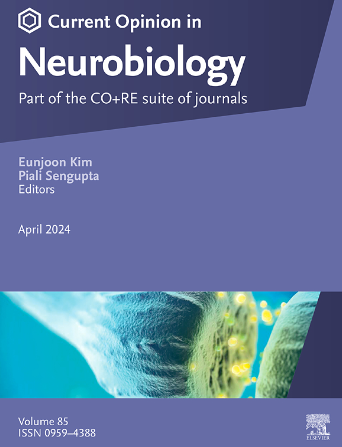Neuromodulatory processing in the bi-pathway brain architecture
IF 5.2
2区 医学
Q1 NEUROSCIENCES
引用次数: 0
Abstract
The brain is inherently a complex and parallel system that processes both external and internal sensory cues to generate adaptive responses. Sensory cues encapsulate not only objective information about their physical and chemical properties but also subjective information related to their ecological significance. Objective information is processed and conveyed through relatively stereotyped sensorimotor pathways to drive behaviors, while subjective information is received and transmitted through relatively flexible neuromodulatory systems. These neuromodulatory pathways influence signal processing of the sensorimotor pathways at multiple stages by modulating neuronal excitability and the efficiency of synaptic transmission, thereby endowing animals with flexibility. This sophisticated neuromodulatory processing is finely tuned by the spatiotemporal dynamics of various neuromodulators released from specialized neuromodulatory neurons that encode sensory, motor as well as cognitive variables. Dysfunctions in neuromodulatory pathways disrupt spatiotemporal patterns of neuromodulators, which in turn compromise sensorimotor transformation and cognitive functions. This review aims to delineate the mechanisms and roles of neuromodulatory processing within the bi-pathway brain architecture and propose prospective research topics along with innovative experimental paradigms.
双通路脑结构中的神经调节加工
大脑本质上是一个复杂的并行系统,它处理外部和内部的感官线索,以产生适应性反应。感官线索不仅包含有关其物理和化学性质的客观信息,还包含有关其生态意义的主观信息。客观信息的处理和传递是通过相对刻板的感觉运动通路来驱动行为的,而主观信息的接收和传递是通过相对灵活的神经调节系统来实现的。这些神经调节通路通过调节神经元的兴奋性和突触传递的效率,在多个阶段影响感觉运动通路的信号处理,从而赋予动物灵活性。这种复杂的神经调节过程是由专门的神经调节神经元释放的各种神经调节剂的时空动态精细调节的,这些神经调节剂编码感觉、运动和认知变量。神经调节通路的功能障碍破坏了神经调节剂的时空模式,从而损害了感觉运动转化和认知功能。本文旨在阐述双通路脑结构中神经调节加工的机制和作用,并提出前瞻性的研究课题和创新的实验范式。
本文章由计算机程序翻译,如有差异,请以英文原文为准。
求助全文
约1分钟内获得全文
求助全文
来源期刊

Current Opinion in Neurobiology
医学-神经科学
CiteScore
11.10
自引率
1.80%
发文量
130
审稿时长
4-8 weeks
期刊介绍:
Current Opinion in Neurobiology publishes short annotated reviews by leading experts on recent developments in the field of neurobiology. These experts write short reviews describing recent discoveries in this field (in the past 2-5 years), as well as highlighting select individual papers of particular significance.
The journal is thus an important resource allowing researchers and educators to quickly gain an overview and rich understanding of complex and current issues in the field of Neurobiology. The journal takes a unique and valuable approach in focusing each special issue around a topic of scientific and/or societal interest, and then bringing together leading international experts studying that topic, embracing diverse methodologies and perspectives.
Journal Content: The journal consists of 6 issues per year, covering 8 recurring topics every other year in the following categories:
-Neurobiology of Disease-
Neurobiology of Behavior-
Cellular Neuroscience-
Systems Neuroscience-
Developmental Neuroscience-
Neurobiology of Learning and Plasticity-
Molecular Neuroscience-
Computational Neuroscience
 求助内容:
求助内容: 应助结果提醒方式:
应助结果提醒方式:


